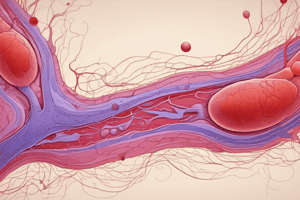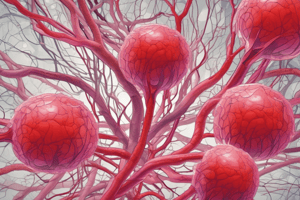Podcast
Questions and Answers
What role do endothelial cells play in the regulation of blood clotting under normal conditions?
What role do endothelial cells play in the regulation of blood clotting under normal conditions?
- They only inhibit coagulation without affecting other clotting processes.
- They have no significant role in thrombus formation.
- They maintain a balance by preventing excessive bleeding and clot formation. (correct)
- They promote clot formation by increasing platelet aggregation.
What happens to endothelial cells following injury or activation?
What happens to endothelial cells following injury or activation?
- Their ability to lyse clots is unaffected.
- Their antiplatelet properties are enhanced.
- They tend to acquire additional procoagulant activities. (correct)
- They completely stop producing anticoagulant factors.
Which of the following describes a normal function of endothelial cells?
Which of the following describes a normal function of endothelial cells?
- They produce only procoagulant factors.
- They primarily act as a barrier preventing any coagulation activity.
- They inhibit coagulation through the release of anticoagulant factors. (correct)
- They enhance platelet adhesion to promote clot formation.
What is the primary consequence of endothelial cells failing to exhibit their normal antithrombotic properties?
What is the primary consequence of endothelial cells failing to exhibit their normal antithrombotic properties?
Which of the following properties do endothelial cells actively exhibit to prevent thrombosis?
Which of the following properties do endothelial cells actively exhibit to prevent thrombosis?
Study Notes
Blood Clotting Regulation
- A dynamic balance exists between blood clotting and anti-clotting mechanisms.
- Endothelial cells play a crucial role in maintaining hemostasis, influencing thrombus dynamics.
Endothelial Cell Functions
- Endothelial cells possess antiplatelet, anticoagulant, and fibrinolytic properties under normal conditions.
- They produce factors that:
- Block platelet adhesion and aggregation.
- Inhibit coagulation processes.
- Facilitate clot lysis.
Changes Post-Injury
- Following vascular injury or activation, endothelial cells exhibit increased procoagulant activities.
- The shift from anticoagulant to procoagulant states is essential for proper hemostatic response.
Importance of Homeostasis
- The balance between the anti-thrombotic and pro-thrombotic activities of endothelial cells is vital for preventing thrombosis and ensuring blood flow.
Studying That Suits You
Use AI to generate personalized quizzes and flashcards to suit your learning preferences.
Description
Explore the balance between blood clotting and the mechanisms that prevent it. This quiz focuses on the role of endothelial cells in regulating hemostasis and their properties after injury or activation. Test your knowledge on the intricacies of thrombosis and its regulation.




